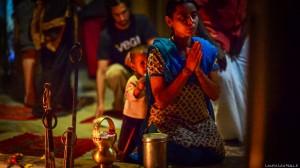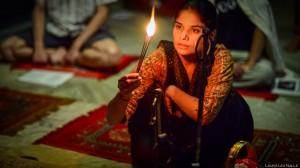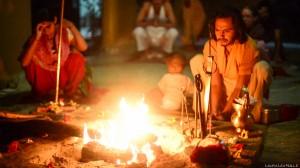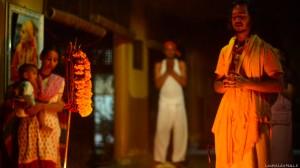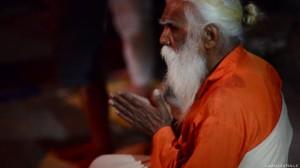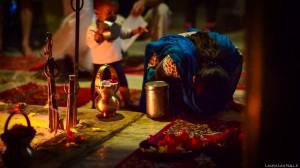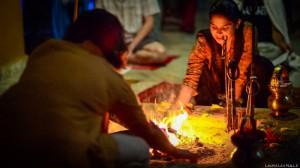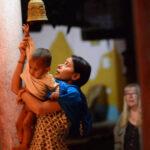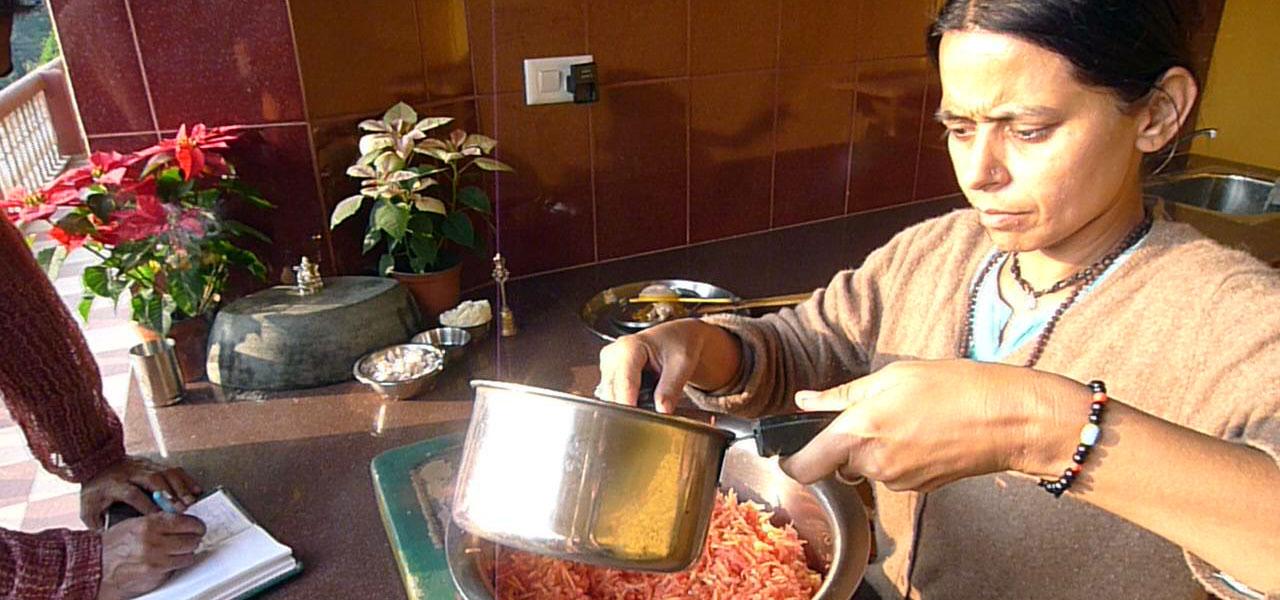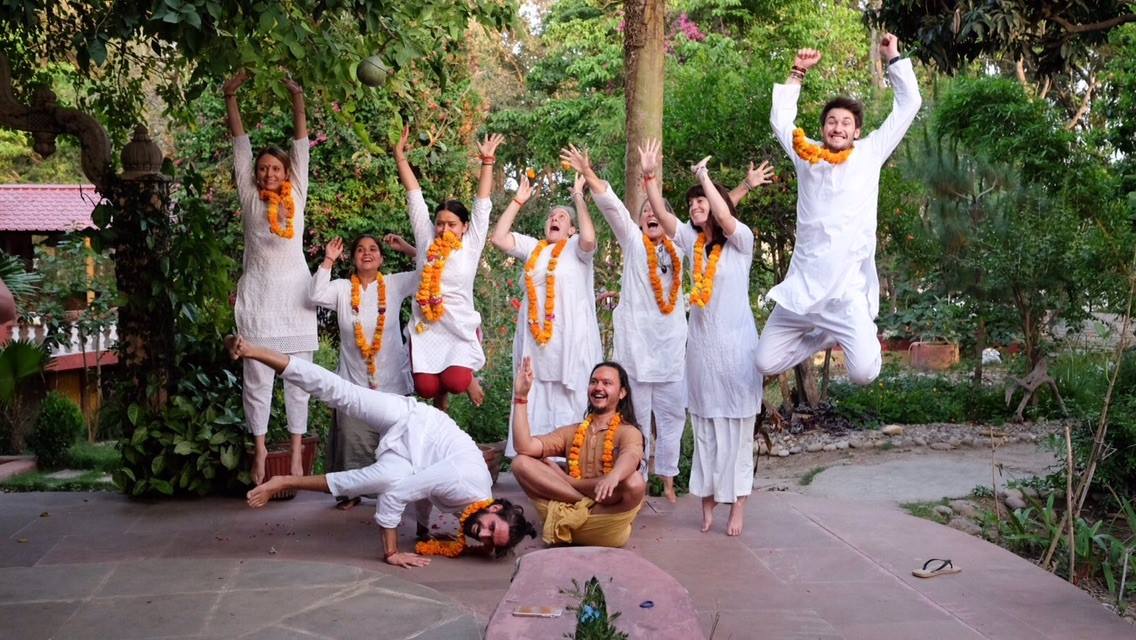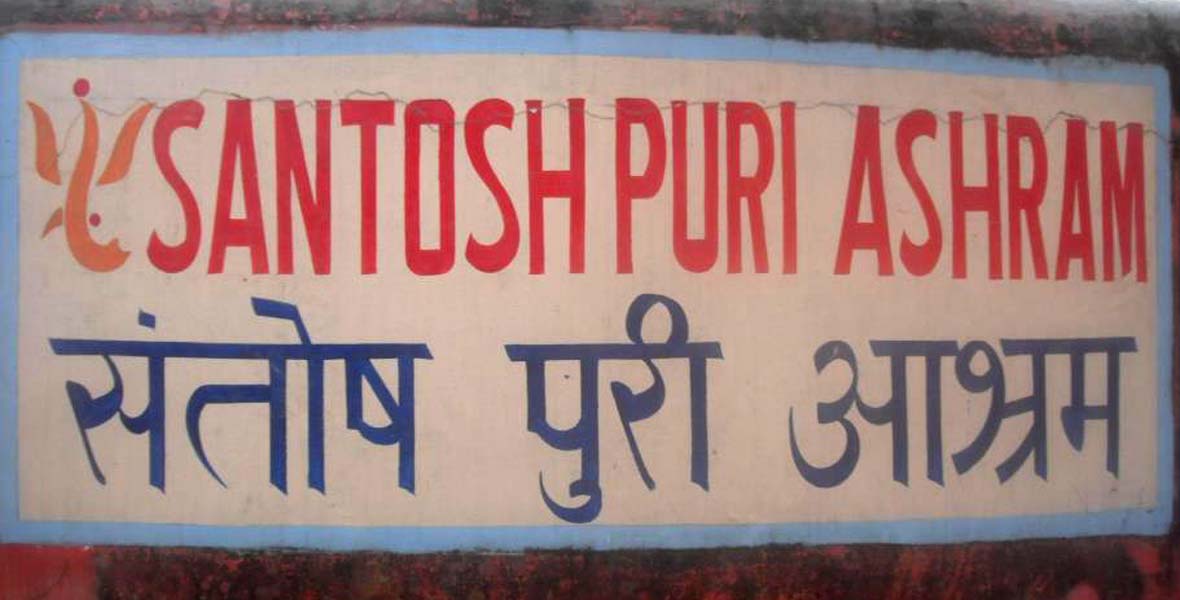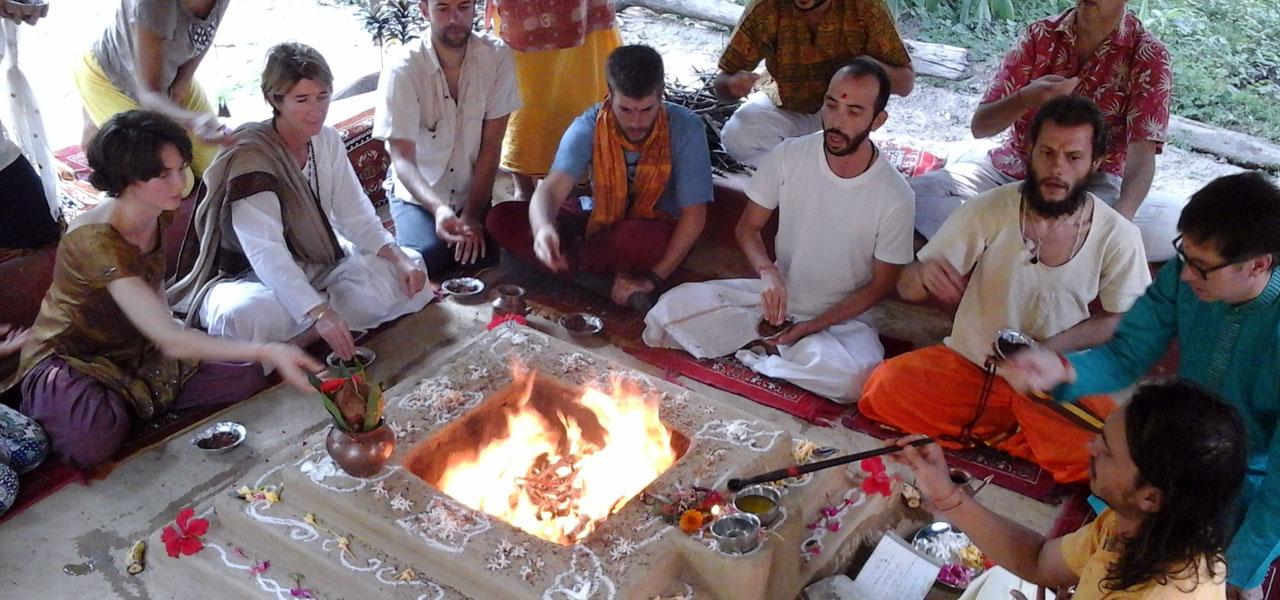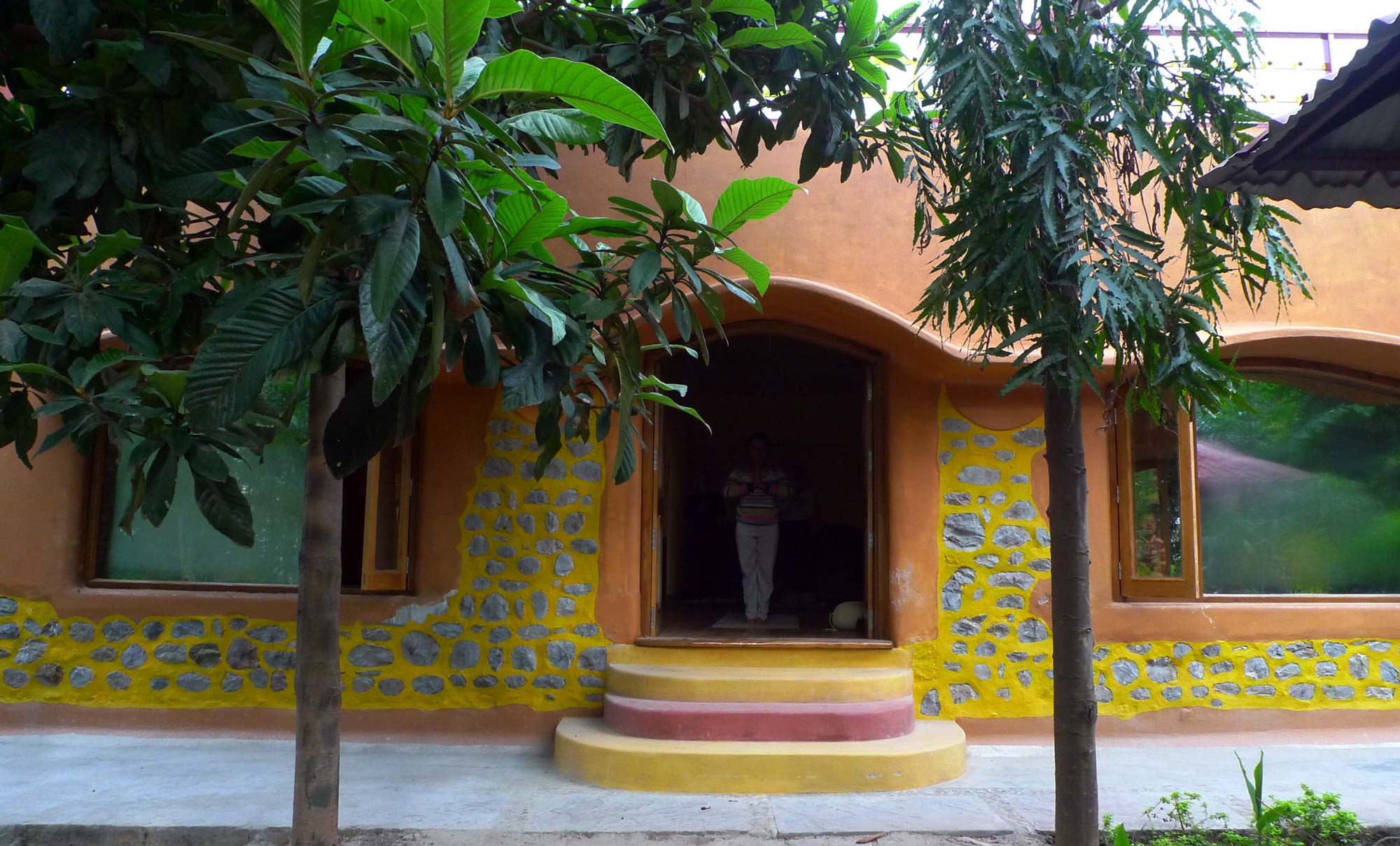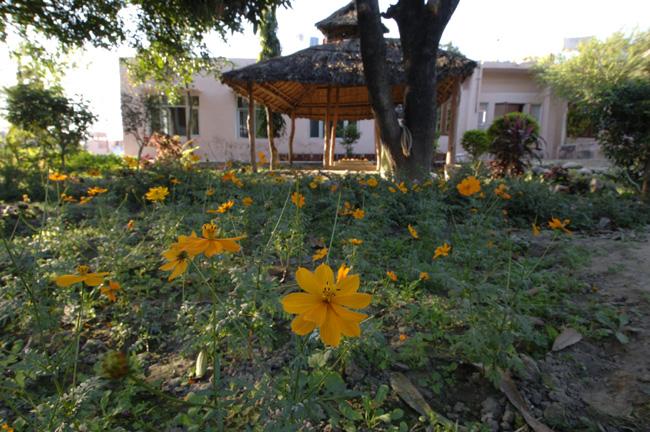The Art of Aarti:
Devotional Salutations to the Divine
Aarti begins at the dhuni, a fireplace worshiped by nagas and avadhootas. It is where the fires of sacrifice consume your ego and anything that you offer to it with surrender and devotion. The practitioner sees the external fire inside himself and tests everything and everyone with the purity of the fire through his sacrifice to it.
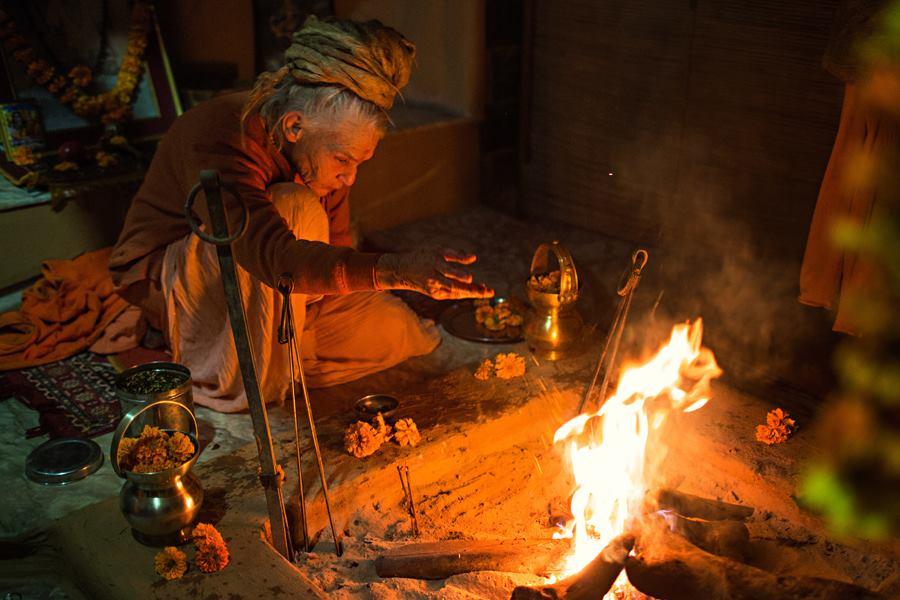
Prayer to the Dhuni:
The prayer of/to the dhuni begins with the sounding of the double-headed damaru (a drum) awakening and bringing all dualities into oneness. All the syllables of sanskrit have come from this double-headed damaru centrally vibrating with the sound of AUM, the vibration of oneness. The call of the conch is also the vibration of AUM transformed into the mantra “Dutt Datta Alak” (“we are awakened by the trinity – giver, retainer, dissolver”) inviting the Gods for worship.
Dhuni Yagya:
The dhuni yagya is performed by first pouring water around the dhuni and base of the trishula (representing the 3 gunas) to purify the space. Then yagya samagri is offered to the fire, a sacrificial food consisting of various kinds of seeds which make up the five elements. This food combines with the fire to create the harmony of the surrounding five elements (earth, water, fire, air, ether).
Devotional prayers and mantras are chanted in sanskrit to awaken the chakras and acknowledge the divine in its many forms and as Formless One.
Please note: The dhuni space, fire and ash are sacred, do not point or touch your feet to the dhuni; do not touch the dhuni or ash without first having bath; do not throw anything into the dhuni (including sticks or ash that the fire has thrown out!).
Temple Worship & Its Symbolism:
The temple itself is the samadhi of the enlightened master and resembles the body standing with the strength of the 16 siddhas. The base level represents the tamas guna. The first step is a higher level of tamas guna, where one begins to leave the ego behind, transitioning into the next step which represents rajas guna. The third step represents the level of sattva guna. The next higher level is where the Shiva lingam resides in nirguna, which is beyond all three gunas, and symbolizes the manipura chakra. Here Shiva and Shakti reside with the blessings of the master.
The steps also represent part of the 8-fold path of ashtanga yoga. The first step being a symbol for yama and the muladhara chakra; the second symbolizing niyama and the svadisthana chakra; the next level, where the lingam resides is the asan and the manipura chakra and also holds the space for the ishta-devata Rudra. The fire under the seat of Babaji is an eternal flame known as the akhand jyoti, which is the light within the master. We touch the feet of the master in order to discover our own light within.
The Shiva lingam is believed to come from the infinite, having no beginning or end, although appearing to be attached to the earth. The nectar of immortality (Ganga water) is continuously poured over the lingam to purify it. It is also the divine nectar that is poured from the awakened master to the disciple. The pot holding this sacred water is suspended over the lingam sitting on a three-legged stand each representing one of the gunas. It slowly falls over the lingam, around the yoni and into the earth flowing northward toward the bael tree sacred to Shiva. Because it is considered to be divine nectar, it is never crossed during worship.
The enlightened master resides in the anahata chakra which is the level above the akhand jyoti. Above this, where the pillars end, is the space of the vissudhi chakra.
Puja:
Singing the Praises of the Enlightened Master
Puja begins by giving devotional salutations to Lord Ganesha thus invoking his protection and blessings. Next a salutation is given to Guruji singing the glories of the master followed by various sthutis (chants in praise of the Lord) chanted in Sanskrit glorifying Lord Shiva and Shakti. More praises are chanted for the master who has blessed us with his knowledge and his presence to awaken us to the level of the infinite thus giving the darshan (divine glimpse) of Shiva.
Next an Omkar is given to the Master and then a prayer to Mother Ganga, symbolizing the constant flow of purity and essence of divinity. The final devotional salutation is offered to the goddesses Chandi and Mansa.
A parikrama is then made around the temple, a way of traveling around the world which is represented by the master in the center. One has already been prepared to transcend the gunas by reciting the above salutations and can then stand under the bell. By ringing the bell, which carries the vibration of aum, and by silently sounding aum within one is now purified and ready to offer flowers to the God in the form residing in the stability of the stone of Narmadeshwar. Now float/move with folded hands traveling around the master in a clockwise direction offering devotional salutations for his blessings. When coming to the river of divine nectar flowing downward, give devotional salutations to the mother residing with consciousness at the yoni. Take the divine nectar to one’s heart and then float back in a counter-clockwise direction making a full circle coming to the yoni once again.
The final chants are recited bringing harmony and completion to Shiva and Shakti. A peace chant and the last glorification of the master who resides in Truth is sounded three times each while raising hands to the openness of infinity and bringing them back to the space of the heart in anjali mudra. “Bolo sache darbar ki jai” is glorifying the gateway of the Lord of truth. “Hara Hara Mahadev” declares that the infinite moves in both directions and divinity has no beginning or end.
The temple priest then brings the light of aarti and the light of the master floats into us along with the blessings in the form of prasaad coming from the divine. We receive this in both hands with the right resting on top of the left thus being blessed by the fruit that moves toward the God residing within us.
NOTE: full Sanskrit and English versions of the chants and mantras from Aarati are found at the duni so guests may join in the chanting.

